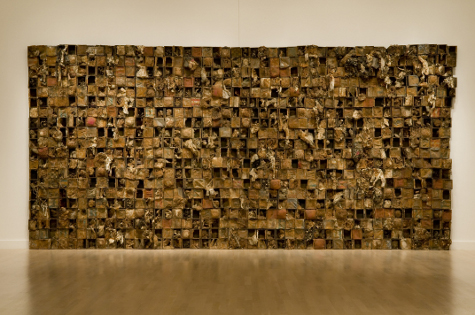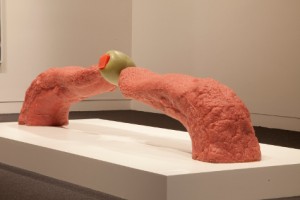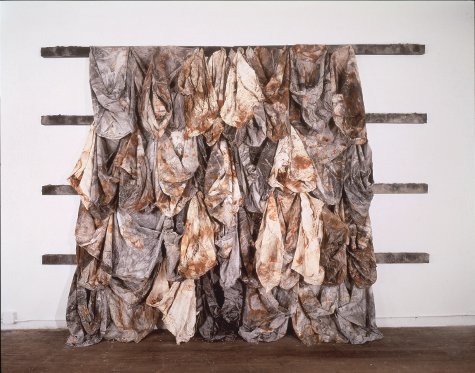Visual Arts Review: The Art of Leonardo Drew — An Abstract World Subject to Abstract Laws
Leonardo Drew has taken Louise Nevelson’s signature Cubist cabinets and turned them into something greater.

Leonardo Drew: Number 43 — Its ramshackle order, barely preserved, evokes refugee camps seen from the air.
By Franklin Einspruch.
The career arc of Leonardo Drew began curling upwards over 20 years ago, and by the time his reputation had spread nationally in the early 1990s, identity politics had become an established feature of the art world. Consequently, some of the appreciation of his work at the time was too pat. After all, here was a black man working with cotton as a medium and otherwise providing low-hanging fruit for the critical establishment.
But while race bears upon his work, its driving force is not so much identity as humanity. In his art, currently on display in Existed: Leonardo Drew at the DeCordova Sculpture Park and Museum, that humanity has two main expressions. The first is a sense of usage and wear, as he puts forms together from lovingly distressed materials that remind the viewer of cherished, weather-beaten objects, things that were preserved in harsh conditions but preserved all the same. The other expression is a concerted grappling with the history of large-scale abstraction and aspirations to some of the same successes. A simplistic rendering would depict these strains as African and American respectively, but they play off of each other in a way that undermines a sharp distinction. Ultimately, Drew’s references operate in an abstract world, subject to abstract laws.
Although Drew arranges matrices of weathered metal, discarded wood, stained cloth, and other castoff material, the matrix itself derives from the works of Louise Nevelson. I wouldn’t be the first to note the connection. Robert Shuster, writing for the Village Voice earlier this year, said that you might end up with a Drew if you left a Nevelson in a forest for several years. However, I may be the first to claim that Drew’s work fulfills a possibility suggested in Nevelson’s, never fully delivered by Nevelson herself, that one could aggregate compartments into a sturdy, artistic vehicle. Drew has taken Nevelson’s signature Cubist cabinets and turned them into something greater.
Drew and Nevelson convey similar gravitas. But in Nevelson’s case, I long suspected that anything larger than six feet, painted flat black, would look equally serious at first glance, maybe even a fence, and that the early impression would wear off. I confirmed this when I saw multiple Nevelsons next to one another, which rendered half of them redundant. More recently, I saw the installation of Rothko black paintings in the tower of the National Gallery in Washington, D.C., in which one can listen to the orchestral work that Morton Feldman wrote to accompany the series. Although not quite at that level—which is as close as one needs to come, in the name of art, to staring into the existential abyss—Drew’s better works rise to within admirable proximity.
I include among those better works Number 43 from 1994, in which the artist has arrayed 800 boxes into a 24-foot-wide wall, each of which contains a burst of stained fabric, crumpled plastic, or a distressing void. It looks like the supply room of a doll maker after a near strike by a mortar. Its ramshackle order, barely preserved, evokes refugee camps seen from the air or a shantytown crowded to maximum density at the expense of some of its inhabitants.
At the same time, one can follow the harmonious distribution of white cloth around the piece, or the orangish bulges, or the black shadows. It employs an all-over composition of the type formulated by Jackson Pollock, set forth anew in wood, rust, and strips of cotton canvas. Dates on the work could categorize it as a late manifestation of neo-expressionism, relating it to Anselm Keifer, for one, but it escapes the period feel of much of that category by operating on a more substantial structure.
When an artist avoids intense colors for an entire oeuvre, one is obliged to wonder whether he has no appreciable sense for it, or whether he is working a narrow range for as much intensity as he can wring from it. Drew’s case is the latter. This is apparent from Number 26 from 1992, in which he has draped an arrangement of cloth from four horizontal slats, forming a voluminous patchwork of warm rust and cold soot.
Drew’s talent founders at smaller sizes. His two-foot-wide pieces look pinched, fiddly, and unexpectedly precious for having been made from dirty sticks and torn paper. This isn’t merely a formal problem, as it robs the works of drama. They cease to recall the rags of slaves and beggars, nostalgic troves of jetsam, the reclamation of human efforts by nature, and architecture blasted by conflict. Instead they resemble paper-pulp art and twig collages of the most banal sort. The chronology of the show indicates that he has been favoring these smaller pieces in recent years. Given a bent to fiddle, he’s better off doing so on a large scale such as his Number 94 from 2005, in which he has cast hundreds of toys, discarded machines, and unrecognizable remnants thereof in paper and hung them in a cascading curtain of white, funereal in the Japanese manner. This waterfall of detritus serves as a reminder of all the trash we produce, but one with a ghostly, memorial quality.
Rubbers, an exhibition of work by Martha Friedman, is on display nearby. Working with cast rubber as a medium and the intersection of food and sex as a subject, she seems to have been brought in for contrapuntal levity. In Ladies Room from 2010, two cow tongues, enlarged to four feet long, support an olive between them, forming a bridge of insouciance with, I suppose from the title, lesbian overtones. Maybe it’s my fault for not shifting gears fast enough, but the abrupt move from Drew to Friedman made the latter look vacuous. In a booklet about the exhibition, curator Dina Deitsch described the olive, stuffed with a pimento, as “a not-so-subtle reference to female anatomy.” The pieces demand facile associations and give back mild, Freudian thrills.
When it comes to the arts, sex is better when understated. This accounts for the success of the titular work in the show, in which Friedman joined giant, multicolored rubber bands two by two and stretched them floor-to-ceiling. One may walk through them and touch them, at which point they reveal an unmistakable fleshy tautness. The fact that rubber bands are more or less skin-toned gives the ensuing knots a lusty charge, and we can only imagine what exciting characters the teal and chartreuse ones stand for. Her five-foot, cast-rubber slices of olive loaf are harmless goofs on geometric abstraction with no ribaldry to speak of, pimentos notwithstanding. There’s something to it all, a delightful if silly Oldenbergesque take on the world with a dollop of Eros.
But just as a gourmet restaurant need not serve deli meats, the DeCordova need not bother with the younger artists of the Chelsea gallery system, of which the Yale-educated, Brooklyn-based, punchline-driven Friedman is a typical example. A locavore approach would turn up more interesting figures. The museum’s Platform Series ostensibly supports as much, but only one of the three Platform displays on view at the moment includes a New England artist. One needs no further encouragement to wonder what kind of baloney is going on behind the scenes at some of our regional museums.
Tagged: DeCordova Sculpture Park and Museum, Franklin Einspruch, Leonardo Drew, Martha Friedman, New England



